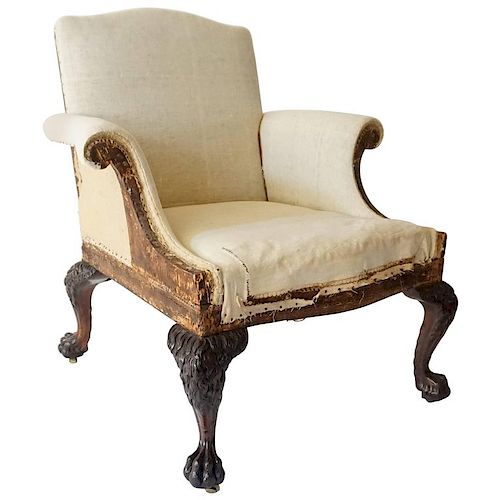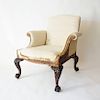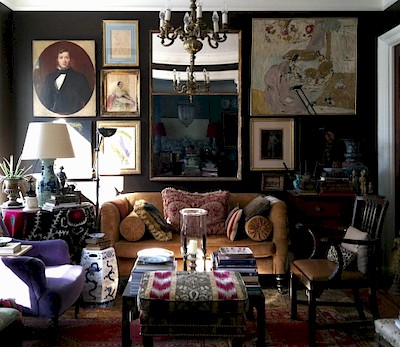Armchair by Lenygon & Company, England, c. 1905
About Seller
7 Broad Street*, *By Appointment Only
Kinderhook, NY 12106
United States
A C R O T E R I O N: 'The Highest Ornament' ~ The word 'acroterion' is an ancient architectural term originally used by the Greeks, and adopted by the Romans as 'acroterium', which literally is the plinth and ornament on the apex or ends of a pediment, from the Greek akrōtḗrion (ἀκρωτήριον) meaning ...Read more
About Auction
Mar 5, 2019 - Apr 1, 2019
A C R O T E R I O N is pleased to present its first ever sale of exceptional fine and decorative arts from current inventory with discounts from 25% to 70% off of original retail prices. Welcome spring with this rare opportunity. ACROTERION info@acroterion.com
- Lot Description
Retail: $13,550 An important and exceptional circa 1905 George II style library armchair of large-scale by the renowned London firm of Lenygon & Company having upholstered "camel-back" form crest-rail, outward swept scrolling arms, and deep seat on dramatic and exquisitely carved mahogany 'hairy' legs ending in large paws. Seat depth: 26". Stamped under front seat rail 'Lenygon & Co.' The firm of Lenygon & Company, whose premises were at 31 Old Burlington Street, London, had an important clientele of aristocratic and wealthy patrons including the Duke of Devonshire, the Earl of Pembroke, and W.H. Lever, later Lord Leverhulme, for whom they worked as decorators and suppliers of antique and reproduction furniture. In 1909 Francis Lenygon, the owner of the firm, published The Decoration of Furniture of English Mansions during the Seventeenth and Eighteenth Centuries. Born in England in 1877, Lenygon was trained as a cabinetmaker and studied at the South Kensington Museum in London. By 1900, he found work with Art Workshops, Ltd., and soon after with Charles Duveen, son of Sir Joseph Duveen. Employed by C.J. Charles for several years, Lenygon became well-known as cabinetmaker to England's artisocracy. He opened his own firm, Lenygon & Co., in 1904, and in 1912 merged with Morant & Co., to become Lenygon & Morant, holding royal warrants under four successive British kings. In 1910, Lenygon made his first visit to the United States to supervise the interior decoration of Whitlaw Reid, and soon opened a New York branch of his firm. As in England, Lenygon's American clients were wealthy and sophisticated and relied on Lenygon to furnish authentic and reproduction interiors in period styles. In the 1930s, Lenygon was hired by Nelson Rockfeller to serve as a major consultant to the reconstruction of Colonial Williamsburg in Virginia, and selected all the furnishings for the Governor's Palace there. Lenygon was widely known for his expertise in 17th- and 18th-century British furniture and interiors and lectured widely on the subjects. He served as president of the American Institute of Decorators and the Art and Antiques Dealers League of America. He was also a Fellow of the Royal Society of Arts and the North British Academy. Lenygon died in New York City in 1943. He was survived by his second wife, Jeanette Becker Lennygon, whom he married in 1926. Jeannette was also a well-respected interior designer, best known for her redecoration of several rooms in the White House during John F. Kennedy's presidency, the interior redecoration of Gracie Mansion for New York mayor John Lindsay, and a founding member of the American Institute of Interior Designers.
Dimension
Height: 38.25 inWidth: 35.00 inDepth: 33.50 inDepth: 33.50 inExcellent. Wear commensurate with age and use. Stripped of upholstery.Condition
- Shipping Info
-
A C R O T E R I O N will assist buyer with shipping arrangements to best ability. In-house packing not available, but delivery and drop-off to Albany, NY FedEx pack and ship location offered at no charge for smaller items. Buyer is free to use shipper of their choice and dealer will assist with shipper recommendations if needed. International buyers are responsible for their own shipping arrangements. Buyer responsible for all shipping costs and will pay shipper directly.
-



 EUR
EUR CAD
CAD AUD
AUD GBP
GBP MXN
MXN HKD
HKD CNY
CNY MYR
MYR SEK
SEK SGD
SGD CHF
CHF THB
THB



















